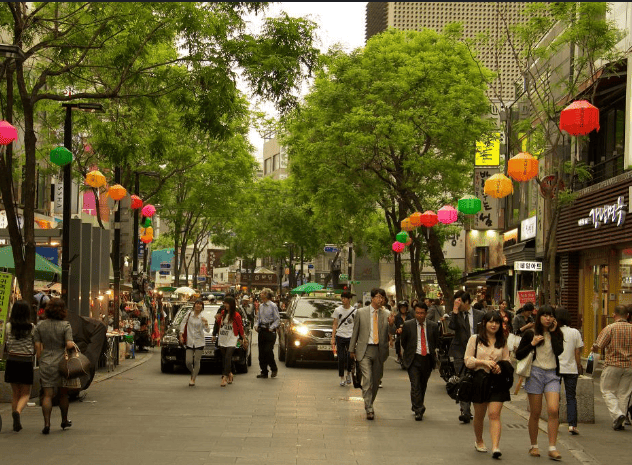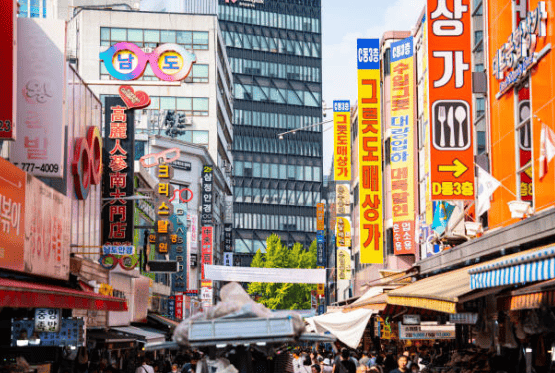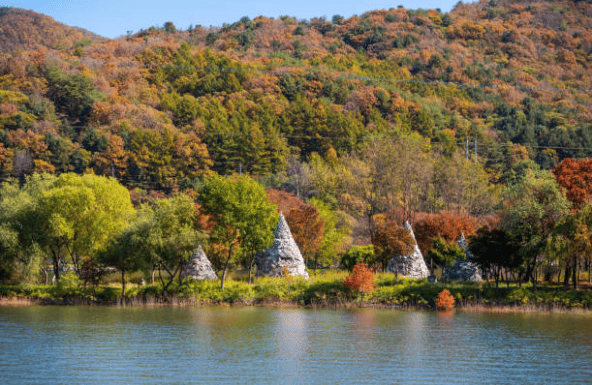It had been a long time since I last visited Seoul, South Korea. The last time I was there was in July 2017. Finally, in December 2023, my child suggested we take a holiday. Since the end-of-year vacation period was short, giving us only three full days in South Korea, we focused our visit on Seoul and its surrounding areas. What can we see in such a limited time? Here are some interesting places we managed to visit within those three days:
Gyeongbokgung Palace

This is perhaps South Korea’s most iconic tourist attraction. Originally built in the 14th century during the Joseon Dynasty, this palace complex served as the main residence for the royal family until the late 16th century. During the Japanese invasion in 1592, the complex was destroyed and remained abandoned for nearly 300 years before being rebuilt in 1867.
Today, tourists at Gyeongbokgung Palace can visit the main Gwanghwamun Gate, which is guarded by royal guards dressed in traditional costumes, complete with imperial banners. Periodically, the guards perform a ceremonial walk around the main gate, an attraction eagerly awaited by visitors, who are also allowed to take photos with the guards.
After entering the main gate, visitors need to buy a ticket to access the palace grounds. The ticket price is 3,000 won per person, but if you wear traditional Korean clothing, known as hanbok, entry is free. Hanbok rentals are widely available in Seoul, with rates starting from 5,000 won. The main building within the complex is the Geunjeongjeon (throne hall), where the emperor held imperial events and received guests. The emperor’s residence is located in Gangnyeongjeon.
The Gyeongbokgung complex also has a pond with the Gyeonghoeru Pavilion in its center, which served as a banquet hall for imperial guests. When we visited, part of the pond was frozen due to the winter. Unfortunately, the pavilion was closed to visitors during our visit.
National Folk Museum

Located adjacent to Gyeongbokgung Palace, this museum offers free entry. Built in 1945, it houses a collection of artifacts depicting daily life in Korea from prehistoric times through the Joseon Dynasty. In addition to the indoor exhibits, the museum’s outdoor area features traditional houses, statues, and various art installations.
Bukchon Hanok Village

This is a residential area on a hill about 2 km from Gyeongbokgung Palace. Visitors can access it through several entrances, including paths with hundreds of steps or winding asphalt roads. The unique charm of this village lies in its traditional houses, which feature distinctive roofs and walls.
This area gained popularity around 2010 after being featured by local television stations. Previously, it attracted only about 30,000 visitors annually, but now it sees over 1 million tourists each year. Unfortunately, the influx of tourists has caused noise and privacy concerns for local residents, with some displaying signs asking visitors to be quiet or even expressing that tourists are not welcome. If you visit, please be mindful of the residents’ privacy.
Changdeokgung Palace

Also known as the East Palace, due to its location east of Gyeongbokgung, Changdeokgung is one of the five main palaces of the Joseon Dynasty. It served as a royal residence and briefly became the main palace during a power struggle between Emperor Jeongjong and Prince Jeong-An in the 1400s.
The main landmark here is the impressive Donhwamun Gate. Inside the complex, the Injeongjeon Hall is where imperial activities, including coronations, took place. Since 1997, this palace has been recognized as a UNESCO World Heritage site. Like Gyeongbokgung, tickets cost 3,000 won or are free for those wearing a hanbok.
Unhyeongung Palace

This palace complex is relatively small compared to Gyeongbokgung and Changdeokgung. It once served as the residence of several imperial princes, including the father of Emperor Gojong. Gojong lived here until he ascended to the throne of the Joseon Dynasty in the 19th century.
Unhyeongung is located in the city center, close to the Myeongdong night market. Entrance is free, and the buildings here are much simpler in design compared to Gyeongbokgung and Changdeokgung.
Insa-dong

Insa-dong is both a residential and shopping area, with many alleys and shops selling antiques and ceramic goods. For fans of these items, it’s worth exploring this area. Since I’m not particularly interested in antiques, I only made a brief stop here.
Cheonggyecheon-Ro

This is an open recreational area in the heart of Seoul. Located amidst office buildings and shopping districts, its main attraction is the Cheonggyecheon Stream, which flows into the Han River. The stream was modernized in 2005, with stepping stones to cross it. Various lighting and lantern installations line the stream, making it particularly beautiful at night. Numerous restaurants and cafes along the stream make it a popular hangout spot.
Myeongdong

Among the many night markets in Seoul, Myeongdong is likely the most popular with tourists. Located in a shopping district, Myeongdong’s buildings are mainly stores selling branded goods. At night, the streets between these stores are closed to vehicles and filled with stalls selling food, souvenirs, garments, and electronics.
When I visited Myeongdong in late December 2019, the temperature was around -4 degrees Celsius, yet the market remained crowded, so the cold didn’t feel too intense. Although South Korea is a developed country that respects intellectual property, many stalls here sell knockoff products, especially in fashion.
It was interesting to observe the visitors in Myeongdong. Most were young Koreans with styles resembling K-pop or K-drama stars. Many young women shared similar facial features, likely a result of similar plastic surgeons, just as certain features are common among patients of prominent surgeons in Indonesia.
For Muslim visitors, Myeongdong is also a Muslim-friendly area in terms of food. Many food vendors display halal logos on their stalls, with some certifications from the Korean Muslim Council and others from Malaysia.
Nami Island

Nami Island, or Namiseom, is a small island in the Han River in Gangwon Province, about an hour from Seoul. To reach Nami Island, you can take a train from Yongsan Station to Gapyeong, costing 5,200 won. From Gapyeong Station, take a tourist bus costing 6,000 won, which can be used to tour nearby attractions, including Nami Island and Petite France.
Nami Island gained popularity in 2002 when it was featured as a filming location for the Korean drama Winter Sonata. To enter Nami Island, visitors buy a ticket for 13,000 won. Uniquely, since 2006, Nami Island has declared itself a “Microstate.” The entrance ticket is referred to as a visa, and visitors pass through a “Visa Checkpoint” at the immigration counter to board the ferry.
The ferry to Nami Island takes about 10 minutes. Upon arrival, visitors can pick up a map at the information center to help explore the 430,000 square-meter island. This semi-circular island has a diameter of 4 kilometers, with one of its main trails lined by rows of pine trees, a favorite photo spot for Winter Sonata fans.
When I visited, temperatures were below zero, but there was no snow yet. Some of the island’s ponds had already frozen. There was also a children’s area for ice tubing and sledding. As New Year’s approached in 2019, an ice sculpture of the year “2019” became a popular photo spot with lines of visitors waiting for their turn.
In addition to the ferry, Nami Island can also be accessed by zipline. Across from Nami Island is a tower for this zipline, which costs 38,000 won and takes only 3 minutes to reach the island. The zipline ticket includes entrance to Nami Island, and visitors can take the ferry back.
